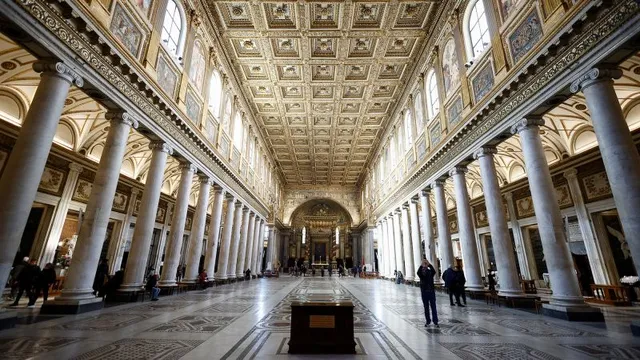
Pope Francis breaks tradition by choosing Santa Maria Maggiore for burial
2025-04-25 14:44- Pope Francis, who died on Easter Monday, chose Santa Maria Maggiore for his burial site.
- This choice marks a significant deviation from the long-standing tradition of burial at the Vatican.
- The decision highlights his devotion to humility and sets a precedent for future popes.
Express your sentiment!
Insights
Pope Francis, who died on Easter Monday 2025, chose to break with tradition by selecting the Basilica di Santa Maria Maggiore as his final resting place. This decision marks the first time in over a century that a pope will be buried outside the Vatican, opting instead for this historic basilica located a few miles away. Santa Maria Maggiore, dedicated to the Virgin Mary, holds a special significance for Francis, as it was a place he frequently visited and revered throughout his life. He expressed a desire for a simpler burial site, reflecting his overall commitment to humility and service to the Church. Before his death, Francis had made it clear that he wished to be buried in Santa Maria Maggiore. The basilica, built in the 4th century, is renowned for its beautiful architecture, including gilded ceilings and rich mosaics. Seven other popes have been interred there, but Francis will be the first since Leo XIII in 1903 to forgo St. Peter's Basilica for his burial. The decision has drawn attention, reflecting a shift in papal traditions. His funeral is scheduled to take place in St. Peter's Square before his body is transported to the basilica for burial. Crowds flocked to Santa Maria Maggiore even before the funeral, showcasing the deep connection people felt with the pope. Visitors expressed their emotions and memories of Francis, highlighting his dedication to his faith and simplicity. The atmosphere in the basilica was filled with a sense of loss as well as celebration of his life and legacy. The decision to be buried in Santa Maria Maggiore also signifies a break from the traditional opulence associated with papal burials, as Francis had requested a humble grave. The burial will occur at Santa Maria Maggiore, following an outpouring of mourning and admiration from the public. The basilica is located in Rome's Esquilino neighborhood and is known for being one of four papal basilicas. As funeral arrangements continue, the legacy of Pope Francis is anticipated to inspire future directions for the Catholic Church, as many hope his successor will uphold his inclusive and humble approach. Many mourners outside the basilica expressed hopes for continuity in his teachings and mission.
Contexts
The tradition of papal burials dates back to the early days of the Catholic Church and reflects the significance of the papal role within the church and its historical connection to the Christian faith. Popes, as the spiritual leaders of the Roman Catholic Church, have historically been buried in locations of reverence, with a particular emphasis on ensuring their final resting places embody their status and the respect they are due. The choice of burial sites has varied over time, influenced by the prevailing religious and cultural practices, as well as the unique circumstances surrounding individual papacies. Traditionally, popes were buried in or near St. Peter's Basilica, a site that has become emblematic of papal authority and the heart of the Catholic Church. The Basilica itself is built over what is believed to be the tomb of Saint Peter, one of Jesus' apostles and the first pope, which adds a deep spiritual significance to the burials occurring there. As we examine papal burials throughout history, it is pertinent to note that these burials have evolved in both practice and style. In the early centuries, popes were often interred within the catacombs of Rome, a reflection of the church's initial clandestine practices during periods of persecution. Over time, as the Church's power grew, so did the grandeur of papal tombs. The Renaissance period heralded a shift towards opulence, with elaborate monuments and artistic tributes marking the resting places of popes. Notable examples include the tomb of Pope Alexander VI, adorned with intricate sculptures and lavish decorations, which exemplifies the artistic ambition of the era and serves as a testament to the historical significance of the papacy. Moreover, the burial practices of popes often embodied the broader cultural influences of their times. For instance, as European society transitioned from the Gothic to the Baroque styles, so did the artistic expressions found in papal funerals and tombs. The appearance and structure of these final resting places not only symbolize the devotion of the Church to its leaders but also reflect the broader sociopolitical context in which these leaders governed. The tombs serve as historical documents that offer insights into the values, artistic movements, and theological beliefs that characterized the era of each pope's reign. In modern times, the significance of papal burials continues to resonate deeply within the Catholic community and beyond. The burial of Pope John Paul II in St. Peter's Basilica in 2005 reaffirmed the tradition's vitality, further embedding these practices in contemporary religious life. His canonization and the subsequent influx of pilgrims to his tomb highlight the enduring connection between the faithful and the spiritual legacy of their leaders. As the tradition of papal burials continues to evolve, it remains a powerful symbol of the bond between the papacy and the Church, illustrating the interplay of faith, history, and art in the ever-unfolding narrative of Catholicism.